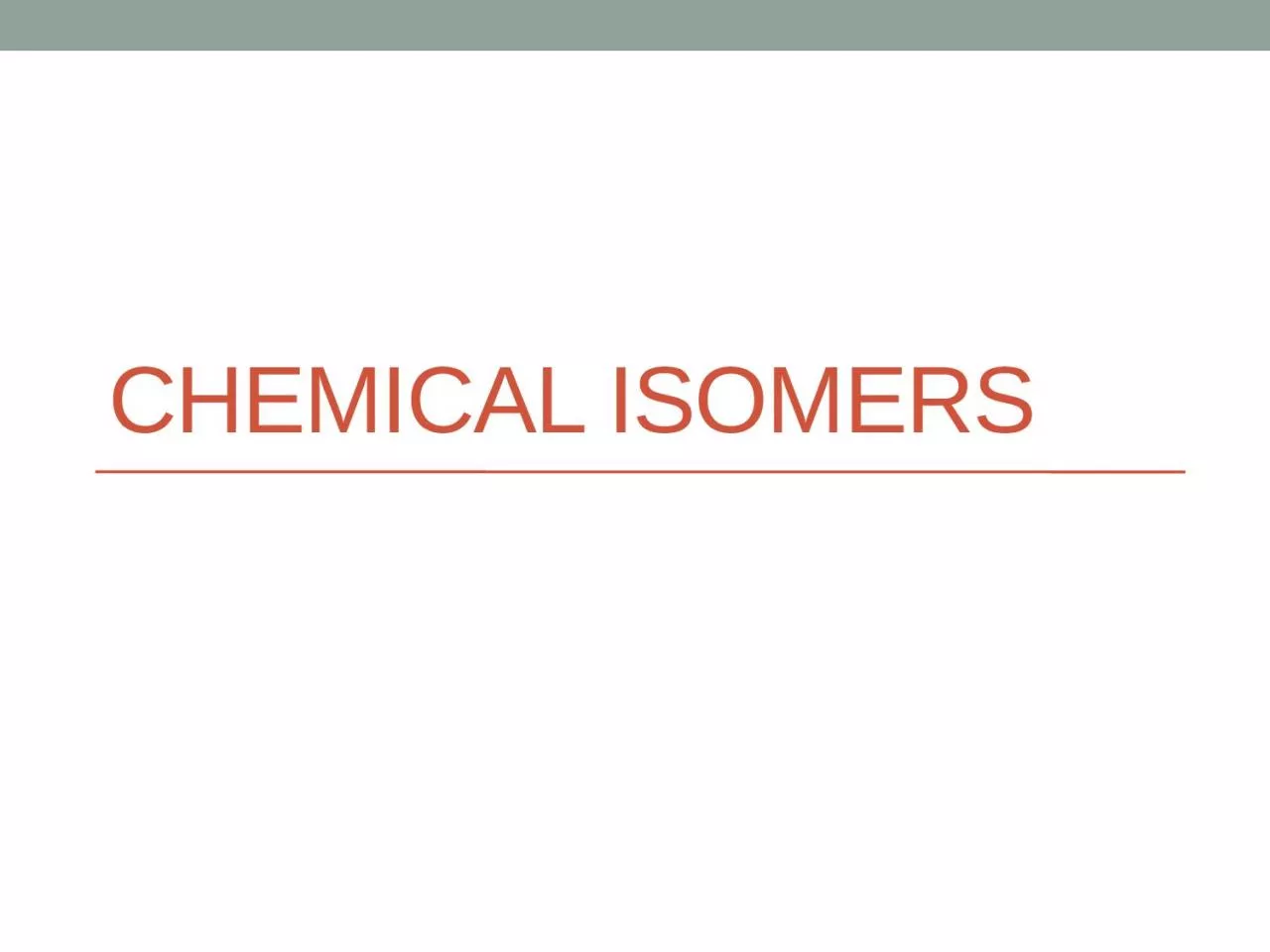

Isomers are molecules that have the same molecular formula but have a different arrangement of the atoms in space What are stereoisomers In stereoisomerism the atoms making up the isomers are joined up in the same order but still manage to have a different spatial arrangement ID: 935159
Download Presentation The PPT/PDF document "Chemical isomers What are isomers" is the property of its rightful owner. Permission is granted to download and print the materials on this web site for personal, non-commercial use only, and to display it on your personal computer provided you do not modify the materials and that you retain all copyright notices contained in the materials. By downloading content from our website, you accept the terms of this agreement.
Slide1
Chemical isomers
Slide2What are isomers
Isomers
are molecules that have the same molecular formula, but have a different arrangement of the atoms in space.
Slide3What are
stereoisomers
In
stereoisomerism, the atoms making up the isomers are joined up in the same order, but still manage to have a different spatial arrangement. Optical isomerism is one form of stereoisomerism.
Slide4Optical isomers
Chiral
molecule is a type of
molecule
that has a non-superposable
mirror image
. The feature that is most often the cause of
chirality
in molecules is the presence of an
asymmetric carbon atom
. The term chiral in general is used to describe an object that is not superposable on its mirror image.
Slide5A
chiral (not chiral) objects are objects that are identical to their mirror image. Human
hands
are perhaps the most universally recognized example of chirality: The left hand is a non-superposable mirror image of the right hand; no matter how the two hands are oriented, it is impossible for all the major features of both hands to coincide.
Slide6This
difference in symmetry becomes obvious if someone attempts to shake the right hand of a person using his left hand, or if a left-handed glove is placed on a right hand.
Slide7In medical chemistry, chirality usually refers to molecules. Two mirror images of a chiral molecule are called
enantiomers
or optical
isomers
. Pairs of enantiomers are often designated as "
right-
" and "left-handed". Molecular chirality is of interest because of its application to
stereochemistry
in
inorganic chemistry
,
organic chemistry
,
physical chemistry
,
biochemistry
, and
supramolecular chemistry
.
Slide8Slide9Slide10symmetry
The
symmetry
of a molecule (or any other object) determines whether it is chiral. A molecule is
achiral
(not chiral) when an
improper rotation
, that is a combination of a
rotation
and a reflection in a plane, perpendicular to the axis of rotation, results in the same molecule - see
chirality (mathematics)
. For
tetrahedral
molecules, the molecule is chiral if all four
substituents
are different.
Slide11A
chiral molecule is not necessarily asymmetric (devoid of any
symmetry element
), as it can have, for example,
rotational symmetry
.
Slide12optical activity: (+)- and (−)- or
D
and
L
An
enantiomer can be named by the direction in which it rotates the plane of polarized light. If it rotates the light clockwise (as seen by a viewer towards whom the light is traveling), that enantiomer is labeled (+). Its mirror-image is labeled (−). The (+) and (−) isomers have also been termed
d-
and
l-
, respectively (for
dextrorotatory
and
levorotatory
).
Slide13Slide14Configuration:
D
- and
L
-
An
optical isomer can be named by the spatial configuration of its atoms. The
D/L
system,
not
to be confused with the
d-
and
l-
system,
see above
, does this by relating the molecule to
glyceraldehyde
. Glyceraldehyde is chiral itself, and its two isomers are labeled
D
and
L
Slide15The
D/L
labeling is unrelated to (+)/(−); it does not indicate which enantiomer is dextrorotatory and which is levorotatory. Rather, it says that the compound's stereochemistry is related to that of the
dextrorotatory
or
levorotatory
enantiomer of glyceraldehyde—the dextrorotatory isomer of glyceraldehyde is, in fact, the
D-
isomer.
Slide16In biology
Many
biologically active molecules are chiral, including the naturally occurring
amino acids
(the building blocks of
proteins
) and
sugars
. In biological systems, most of these compounds are of the same chirality: most amino acids are
L
and sugars are
D
. Typical naturally occurring proteins, made of
L
amino acids, are known as
left-handed proteins
, whereas
D
amino acids produce
right-handed proteins
Slide17In drugs
Ethambutol
: Whereas one enantiomer is used to treat tuberculosis, the other causes blindness.
Naproxen
: One enantiomer is used to treat arthritis pain, but the other causes liver poisoning with no analgesic effect.
Steroid
receptor sites also show
stereoisomer
specificity.
Penicillin
's activity is
stereoselective
. The antibiotic only works on peptide links of D-alanine which occur in the cell walls of bacteria - but not in humans. The antibiotic can kill only the bacteria, and not us, because we don't have these D-amino acids.
S
(-) isomer of
carvedilol
, a drug that interacts with
adrenoceptors
, is 100 times more potent as
beta receptor blocker
than R(+) isomer. However, both the isomers are approximately equipotent as alpha receptor blockers.
Slide18Stereoisomers: isomers that have same
formula
and
connectivity but differ in the position of
the
atoms
in space. They possess one or
more
stereocenters
.
Stereocenter: a carbon atom bearing 4
different
atoms
or group of atoms.
Slide19Chiral: any molecule that is nonsuperposable
with its mirror image.
Enantiomers: stereoisomers that are non
superposable mirror images.
Racemic mixture: a 1:1 (equimolar) mixture of
two enantiomers.
Optically Active: the ability of some
compounds to rotate plane polarized light.